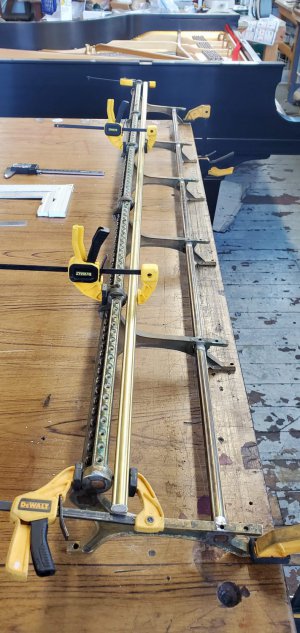- Joined
- Sep 25, 2022
- Messages
- 11
Good morning!
I very well may be in the wrong place for a question such as this but lets see where it leads.
In my profession I am periodically tasked with recreating 100 year old parts that have worn out (I restore pianos). Pianos usually have 88 keys, and there are multiple rails per piano action-stack. In the service of recreating these with the singular alignment that is correct for that piano, the old rails come out and the drill-pattern layout is laboriously copied over to the un-drilled stock in order to be drilled with 'relatively' tight tolerances (I am made aware I am chatting with machinists ).
).
What I have begun dreaming up is a jig thats alignable to the drill press, and, has a raisable / lowerable "bit" of some sort that lands in the hole of the stock I am copying and ensures that the new stock is in the exact right place for the hole that is to be drilled. Building this out once would save me time in the long haul as its laborious to copy over and punch each rail prior to drilling it. I'd be surprised if I am the first craftsperson to dream this up.
Have I explained this well enough? Is there anything here for some of you to run with?
Thanks for your time & Best,
Josh
I very well may be in the wrong place for a question such as this but lets see where it leads.
In my profession I am periodically tasked with recreating 100 year old parts that have worn out (I restore pianos). Pianos usually have 88 keys, and there are multiple rails per piano action-stack. In the service of recreating these with the singular alignment that is correct for that piano, the old rails come out and the drill-pattern layout is laboriously copied over to the un-drilled stock in order to be drilled with 'relatively' tight tolerances (I am made aware I am chatting with machinists
What I have begun dreaming up is a jig thats alignable to the drill press, and, has a raisable / lowerable "bit" of some sort that lands in the hole of the stock I am copying and ensures that the new stock is in the exact right place for the hole that is to be drilled. Building this out once would save me time in the long haul as its laborious to copy over and punch each rail prior to drilling it. I'd be surprised if I am the first craftsperson to dream this up.
Have I explained this well enough? Is there anything here for some of you to run with?
Thanks for your time & Best,
Josh


